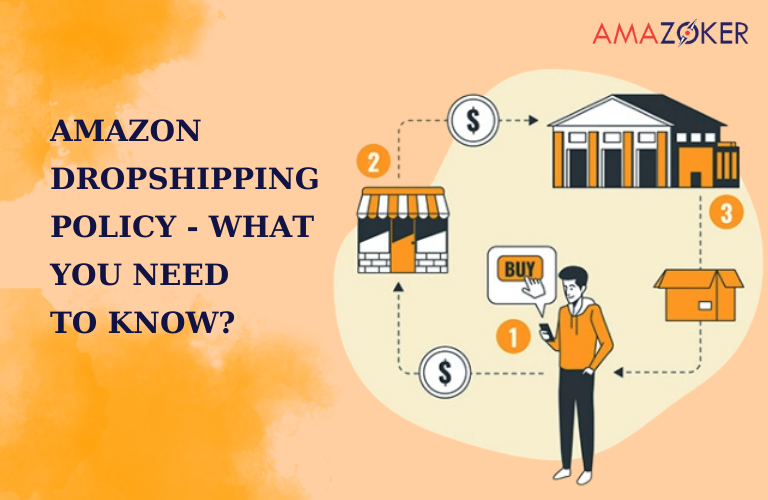Dropshipping is a popular online business model where sellers don’t stock inventory but instead pass customer orders to suppliers who directly ship products to customers. While it offers advantages like cost and time savings, there are key considerations about Amazon Dropshipping Policy.
In this article, we will provide you with essential information about dropshipping while selling on Amazon, addressing common frequently encountered questions regarding Amazon’s dropshipping policy:
- What is Amazon Drop Shipping Policy?
- Rules of Amazon Dropshipping Policy
- Does Amazon Allow Dropshipping?
- How does Dropshipping work?
- Advantages and Disadvantages of Dropshipping on Amazon
- How to choose a Dropshipping Supplier
- How to get started Dropshipping on Amazon
- What to Do If You Violate Amazon’s Dropshipping Policy?
Table of Contents
- What is Dropshipping Business Model?
- Is Dropshipping on Amazon Legal?
- How Does Dropshipping on Amazon Work?
- 5 Typical Errors Amazon Sellers Make in Dropshipping
- Advantages and Disadvantages of Dropshipping on Amazon
- How to choose a Dropshipping Supplier
- How to get started Dropshipping on Amazon:
- What to Do If You Violate Amazon Dropshipping Policy
- Tips for successful dropshipping on Amazon
- Amazon FBA vs Dropshipping: Which option is Right for Me?
- Frequently Asked Questions
What is Dropshipping Business Model?
In the dropshipping business model, you focus on product promotion and maintain an online storefront. When a customer makes a purchase, you relay the order to the dropshipper and notify the customer that their products are in transit.
The remainder of the logistical process is beyond your control. In certain dropshipping arrangements, you might also handle customer service responsibilities, while the dropshipping service takes care of the actual product handling and order fulfillment.
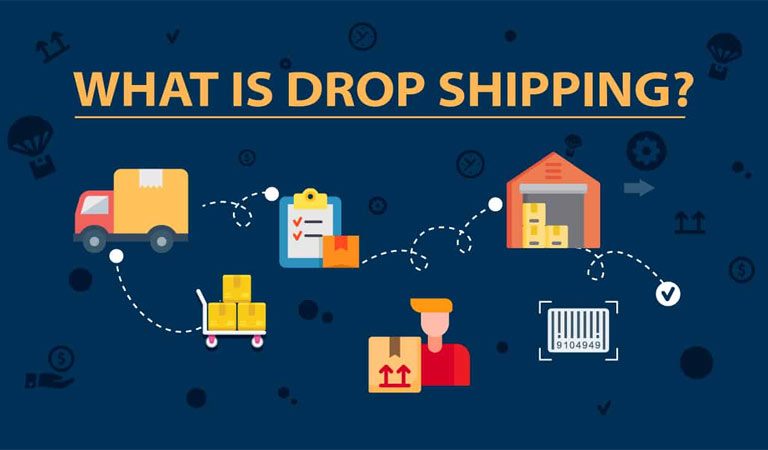
What is Dropshipping Business Model?
Amazon imposes stringent regulations for sellers conducting business on its platform. Any violation poses a risk of suspension or account lockout.
Key practices to adhere to while dropshipping on Amazon include:
- Managing customer returns for your products and ensuring prompt processing.
- Strict adherence to seller agreement terms and Amazon policies applicable to your business.
- Identifying yourself as the product seller on all accompanying materials like packing slips.
Conversely, certain practices should be avoided:
- Purchasing items from another online retailer and having them shipped directly to customers.
- Shipping orders with packing slips, invoices, or details indicating a seller name or contact information different from yours.
Is Dropshipping on Amazon Legal?
Dropshipping on Amazon is entirely legal if you adhere to Amazon dropshipping policy and comply with relevant laws. However, it’s important to note that dropshipping is not always straightforward and comes with its own risks. You need to research the digital market, your products, and your suppliers thoroughly, as well as manage product quality, pricing, and customer service effectively. Additionally, you’ll face intense competition on Amazon.
Amazon has established specific requirements and regulations that sellers on its platform must adhere to. These requirements include:
- Sellers must be the owner of the products or manufacturers.
- Sellers must commit to delivering products on time.
- Product information and delivery must be accurate.
- Adherence to Amazon’s customer service policies.
- Removal of any information about the dropshipping supplier from packages or accompanying documents.
- Not using Amazon services like Fulfillment by Amazon (FBA) or Seller Fulfilled Prime (SFP).
- Violation of this policy can lead to consequences such as removal of products from listings, restrictions on account access, or refund requests from customers.
How Does Dropshipping on Amazon Work?
The dropshipping process involves the following steps:
- Sellers negotiate with dropshipping suppliers regarding products, pricing, and delivery terms.
- Customers place orders through the seller’s online store.
- Sellers review orders and confirm their ability to deliver within the committed time.
- Customers receive order confirmations containing product information, pricing, shipping fees, and estimated delivery times.
- Sellers forward orders and relevant information to dropshipping suppliers.
- Dropshipping suppliers ship the products to customers, preparing and packaging them as per the seller’s requirements.
- Customers receive the products, inspect their quality, and may provide feedback or request returns if necessary.
5 Typical Errors Amazon Sellers Make in Dropshipping
Our experience reveals recurring violations of Amazon’s Dropshipping Policy among sellers, highlighting five common mistakes:
- Sourcing from Other Online Retailers: Procuring items from online retailers like Walmart, eBay, or Home Depot and having them shipped directly to customers violates Amazon policies. This approach leads to confusion as the customer receives items with different packaging and invoices, causing seller identification issues. Adhering to such advice from third-party sources risks losing selling privileges.
- Providing False Tracking Information: Scaling through dropshipping often results in increased sales. Some sellers resort to submitting inaccurate tracking details to mask dropshipping practices. Amazon identifies this as deceptive behavior, posing serious consequences.
- Confirmation without Fulfillment: Stock discrepancies in dropshipping might lead to unfulfilled orders after confirmation. Sellers who overlook stock availability and confirm shipment face fraudulent behavior charges by Amazon.
- Lack of Valid Invoices for Product Authentication: Amazon mandates valid invoices for product authenticity verification. However, purchases from certain retailers lack compliant invoices, leaving sellers unable to validate their products, leading to account suspension.
- Failure to Uphold Corrective Measures: Sellers violating Dropshipping Policies risk account suspension. To reinstate, they must submit an plan of action addressing the violation, corrective actions taken, and preventive measures. Non-compliance with promised actions hinders reinstatement, leading to recurring suspensions.
These pitfalls underscore the importance of adherence to Amazon’s Dropshipping Policy, as repeated violations jeopardize selling privileges.
Advantages and Disadvantages of Dropshipping on Amazon
In the world of ecommerce, every fulfillment approach comes with its own set of advantages and disadvantages. Whether the benefits outweigh the drawbacks largely hinges on your objectives and specific business circumstances. Here are potential advantages and disadvantages to contemplate when evaluating whether dropshipping aligns with your business needs.

Advantages and Disadvantages of Dropshipping on Amazon
Advantages:
Here are some of the advantages to consider:
- No need for stocking inventory, reducing costs.
- Easy to start with minimal initial capital.
- No inventory management or shipping responsibilities.
- Timesaving, allowing you to focus on marketing and advertising.
- Location independence, flexibility to work remotely.
- Multi-channel selling, including your own website, social media, platforms like Amazon, Etsy.
- Flexibility in product selection without much investment.
Disadvantages:
Let’s discover the disadvantages of Dropshipping on Amazon:
- Limited control since you rely on suppliers.
- Difficulty in creating uniqueness as you select from existing products.
- Potential issues with product quality and delivery times from suppliers.
- High competition due to ease of product replication.
- Real-time Inventory management constraints
- Limited promotional flexibility like free shipping, bundling.
- Profit margin pressure due to the lack of unique product features.
How to choose a Dropshipping Supplier
To select a reliable dropshipping supplier:
- Ensure product quality through sample testing and customer reviews.
- Consider costs and calculate overall expenses to ensure profitability.
- Prioritize reputable, experienced, and punctual suppliers.
- Assess their customer service and support in inventory and order management.
How to get started Dropshipping on Amazon:
Starting a successful dropshipping business on Amazon requires careful planning and execution. Here’s an expanded version of the steps to begin your dropshipping journey on Amazon:
1. Register and Verify Your Amazon Seller Account:
To complete the registration and account verification process, please adhere to the following steps:
- Go to Amazon Seller Central and sign up for an account.
- Choose between an Individual or Professional seller plan.
- Provide the necessary information and complete the identity verification process.
2. Market Research and Product Selection:
To select the right products, follow these steps:
- Conduct thorough market research to identify profitable niches or products.
- Analyze competitors, pricing, and customer reviews.
- Use Amazon tools like Best Sellers and keyword research to find popular products.
3. Find Reliable Dropshipping Suppliers:
To successfully find a reliable supplier, adhere to these steps:
- Locate trustworthy suppliers who offer quality products and efficient shipping.
- Contact potential suppliers, discuss terms, pricing, and shipping times.
- Verify the reputation and reliability of your chosen suppliers.
4. Create and Optimize Product Listings:
To complete the product listing creation and optimization, follow the steps outlined below:
- List your selected products on your Amazon seller account with compelling descriptions, images, and titles.
- Optimize your listings with relevant keywords to improve visibility.
- Customize your Amazon store with branding elements.
5. Implement Marketing Strategies:
Implementing marketing strategies requires a well-thought-out plan and execution. Here are the general steps to implement marketing strategies effectively:
- Drive traffic to your Amazon listings through marketing efforts.
- Use Amazon Advertising (e.g., Sponsored Products) to promote your products on Amazon.
- Leverage social media, content marketing, and email campaigns for broader outreach.
6. Efficient Order Management and Customer Service:
Efficient order management and customer service are crucial for ensuring customer satisfaction and the smooth operation of your business. Here are steps and strategies to achieve efficiency in these areas:
- Monitor your seller dashboard regularly for new orders.
- Fulfill orders promptly and accurately, ensuring timely delivery.
- Deliver exceptional customer service by handling inquiries and concerns in a professional manner.
7. Develop a Business Growth Strategy:
Developing a business growth strategy is essential for expanding your company and achieving long-term success. Here’s a step-by-step guide to create an effective growth strategy:
- Examine sales data and customer feedback to enhance and fine-tune your strategy.
- Consider expanding your product range to diversify offerings.
- Explore growth opportunities, such as entering new markets or using Amazon FBA for streamlined fulfillment.
- Stay updated on Amazon’s policies and marketplace trends.
By following these steps, you can lay a strong foundation for your dropshipping business on Amazon. Consistency, adaptability, and a focus on customer satisfaction will be key to your long-term success in the competitive world of Amazon dropshipping. Please note that you should update the drop shipping news regularly to match the dropshipping policy.
What to Do If You Violate Amazon Dropshipping Policy
Violating Amazon’s Dropshipping policy is a common issue for many sellers. To address this problem, sellers need to clearly identify the reasons for the violation and then take corrective actions.

What to do if you violate Amazon Dropshipping policy
Main reasons leading to amazon dropshipping policy violation
Violations of Amazon’s dropshipping policy can occur in various instances, including:
- Failing to Provide Product Sourcing Information: Not furnishing comprehensive and accurate details regarding the source of products, especially if you don’t explicitly disclose that the products are being shipped directly from an external supplier.
- Not Maintaining Quality Control: Failing to monitor or control the quality of products sold on Amazon, resulting in the dispatch of subpar products to customers.
- Using Inaccurate Product Information: Employing misleading images, product descriptions, or misinformation about the product, causing confusion among customers regarding its features or origin.
- Inappropriately Pricing or Employing Discounts: Setting an inappropriate selling price or utilizing unclear discount strategies to compete on Amazon.
How to deal with Amazon Dropshipping policy violation
If you violate Amazon dropshipping rules and face corrective actions, cooperate with Amazon to resolve the situation. If you encounter difficulties while working with Amazon, you can reach out to Amazoker. Their experienced professionals can advise and assist you in addressing policy violations promptly and get your Amazon account reinstated quickly.
Amazoker is a trusted service that thousands of sellers rely on to navigate issues when selling on the Amazon platform. Amazoker has a team of experienced and highly capable experts in handling amazon drop shipping policy on Amazon. Amazoker will assist you in the following ways:
- Analyzing the reasons why you violate Amazon Dropshipping Policy
- Drafting and submitting a professional, persuasive, and compliant action plan
- Monitoring and liaising with Amazon to ensure a prompt and effective appeals process.
- Supporting you in preventing and resolving other potential account-related issues.
With the Amazon Appeal Service, you can have peace of mind and confidence while conducting your business on the world’s largest e-commerce platform.
Contact information Amazoker:
- Website: Amazoker.com
- Phone: +1 580 262 6126
- Email: contact@amazoker.com
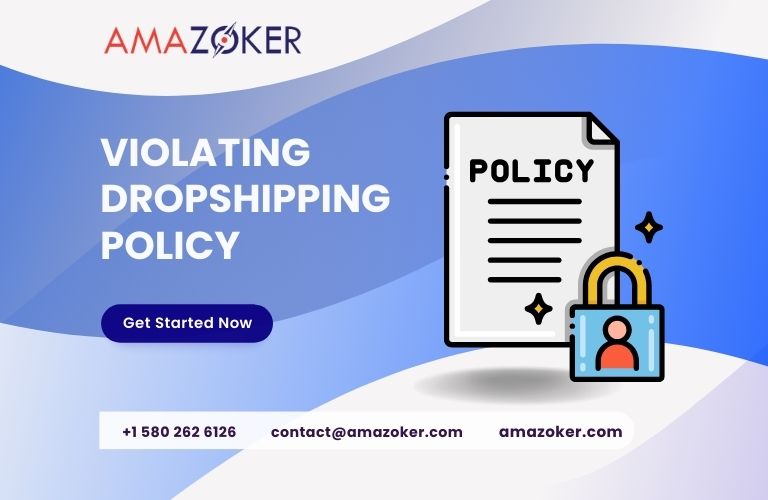
Amazoker appeal service
Ensuring Effective Amazon Dropshipping Practices for Your Business
The dropshipping model attracts entrepreneurs seeking efficiency and cost-effectiveness but requires careful compliance. To use a drop shipper and abide by Amazon’s policy as a Seller, it’s essential to:
- Establish an agreement with your supplier ensuring exclusive identification of you as the seller on all related materials accompanying the products.
- Remove any third-party drop shipper details from packing slips, invoices, or external packaging before dispatching orders.
- Manage customer returns for your products efficiently and effectively.
- Monitor customer satisfaction, reviews, and feedback closely.
- Adhere strictly to your seller agreement terms and all relevant Amazon policies.
Tips for successful dropshipping on Amazon
Certainly, establishing a dropshipping venture on Amazon may seem simpler than other selling methods, but achieving success requires additional effort. Here are five tips to enhance your dropshipping success:
Promote Your Listing:
To boost sales, actively drive traffic to your product listing. Utilize Amazon’s internal sponsorship program, Pay-Per-Click (PPC), creating targeted advertisements that elevate your product in search results. External methods like Facebook ads, social media, blogging, and email marketing can also differentiate your product and attract potential customers.
Prioritize Customer Focus:
With dropshipping, the intricate aspects of entrepreneurship like manufacturing and shipping are streamlined. Redirect your efforts toward impeccable customer service, ensuring customer satisfaction upon receiving the product. Exceptional customer service not only garners positive reviews but also plays a crucial role in the success of your products on Amazon.
Emphasize Your Brand:
Since dropshipping involves selling products with limited influence over development or design, focus on building a distinctive brand. Even if your product is similar to competitors’, a strong brand image sets you apart. Consider the success of YETI, which dominates its product category not solely based on the product but on the desired brand and image it conveys.
Obtain Samples:
Before listing your product, order a sample to understand what you are selling. Thoroughly inspect the sample for appearance, delivery time, and adherence to product descriptions. This firsthand knowledge helps anticipate and address potential issues when dropshipping to customers on Amazon.
Cast a Wide Net:
Leveraging the advantage of low startup costs in dropshipping, diversify your product listings. Cast a wide net by listing multiple products simultaneously, exploring various niches to maximize opportunities and adapt to market trends efficiently.
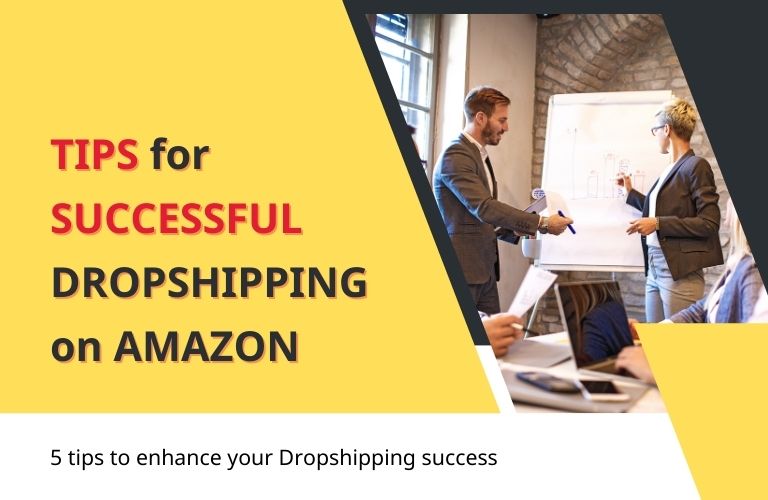
Some advices for Achieving Success in Dropshipping on Amazon will help sellers
Amazon FBA vs Dropshipping: Which option is Right for Me?
For Beginners:
If you’re new, Amazon FBA is often recommended as the more beginner-friendly option. It’s a less hands-on approach that can save you time and effort. With Amazon FBA, you won’t have to worry about inventory management or shipping, as Amazon takes care of these aspects.
However, it’s important to be aware that Amazon FBA does require a significant upfront investment. You’ll incur expenses for Amazon storage, picking, packing, and shipping fees. Additionally, you’ll need competitive pricing and a strong marketing strategy to succeed.
If You’re Already Using FBA:
The choice between Amazon Dropshipping and FBA largely depends on your individual business goals, strategies, and preferences. If you’ve already experienced success with Amazon FBA and are satisfied with the results, sticking with this fulfillment method may be the right decision.
On the other hand, if you’re looking to cut costs, Dropshipping amazon can be a more budget-friendly option. It eliminates the need to pay Amazon fees for storage, picking, packing, and shipping, and you can sell without investing in inventory.
If You’re Already Dropshipping:
The Amazon FBA vs. Dropshipping debate often centers on the level of control sellers have over inventory storage and shipping processes.
If you’ve been successful with Dropshipping but are now looking to enhance your customer service or streamline your fulfillment process, Amazon FBA might be worth considering.
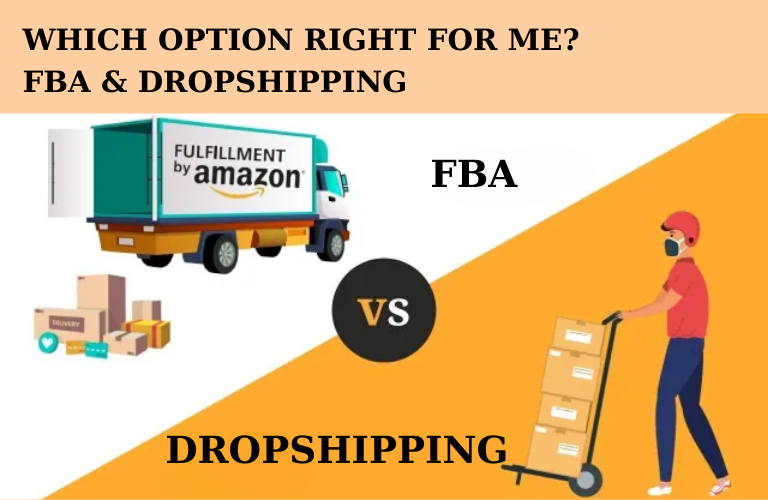
FBA (Fullfillment by Amazon) VS Amazon Dropshipping policy
Frequently Asked Questions
Here are some frequently asked questions about dropshipping on Amazon:
Q: What is dropshipping?
Dropshipping is a business model that enables you to run an online store without the need to own or manage the physical storage and processing of products. This allows you to establish an ecommerce store and offer a diverse range of products without the responsibility of inventory management and fulfillment.
Q: What is dropshipping violation on Amazon?
Dropshipping violations on Amazon can occur when sellers misrepresent shipping times, fail to maintain product quality and accurate listings, or encounter issues with order fulfillment. It’s crucial for dropshipping sellers to adhere to Amazon’s policies, provide excellent customer service, and manage inventory effectively to avoid potential violations and maintain a healthy selling account.
Q: Is dropshipping good for beginners?
Dropshipping represents an attractive choice if you seek a business model with minimal overhead and startup expenses. Nevertheless, it comes with certain trade-offs to weigh, and there are alternative business models that can provide some of the advantages associated with dropshipping.
Q: Is dropshipping illegal on Amazon?
No, dropshipping is a legitimate method of order fulfillment.
Q: What are the rules of dropshipping?
Dropshipping on Amazon requires strict adherence to platform policies, ensuring accurate product listings, maintaining inventory control, and delivering on shipping promises. Sellers must take full responsibility for customer service, promptly addressing inquiries, returns, and any issues related to the orders. Continuous monitoring of metrics, compliance with intellectual property rights, and transparent business practices are essential for successful and sustainable dropshipping on the platform.
Q: What’s the difference between dropship manufacturers, wholesalers, and retailers?
In dropshipping, the seller of record doesn’t directly manage the product; rather, they rely on a third party to locate, store, and ship products directly to customers. Any entity within the supply chain can engage in dropshipping, including manufacturers, wholesalers, and retailers. The role of a manufacturer, wholesaler, or retailer remains consistent regardless of the seller’s chosen fulfillment method.
In summary, dropshipping on Amazon can be a profitable business model, but you must adhere to Amazon dropshipping policy and operate professionally to succeed. Ensure you research your market and products, find reliable suppliers, and provide excellent customer service to build a sustainable dropshipping business on Amazon.







